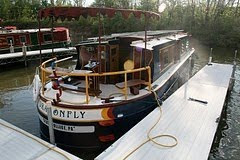Wow! Loads of good guesses for our inaugural 2018 “What Is It” quiz. But this one was a stumper.
The mysterious forged iron thingy is a portable boat
cleat! The resident Rideau blacksmith
made it for us while we watched, in his stone blacksmith shop, unchanged since 1836.
A Job That’s Like Time Travel
 Why does the canal have a resident blacksmith? Well, the Rideau is a
living museum, with lots of antique iron parts: the gears that open the sluice
gates, the gears that open and close the lock doors, the fittings on the doors
themselves.
Why does the canal have a resident blacksmith? Well, the Rideau is a
living museum, with lots of antique iron parts: the gears that open the sluice
gates, the gears that open and close the lock doors, the fittings on the doors
themselves.
The blacksmith works full time keeping all 47 lock stations
supplied. Even in the winter, when the canal is closed, he trudges through the
snow to spend solitary days, hard at work at his forge.
And if he has any spare time, he makes things that we
tourists can buy. Like this cleat.
Why BYOC (Bring Your Own Cleat)?
V
a boat. Usually, when you land at a dock, you see metal cleats every 15
feet or so. You wrap your lines around them in a proscribed way, and the boat
stays put.
ery handy to have on
 |
| No cleats, ring a ding ding. |
Sometimes, though, the dock cleatage is problematical. The
cleats are too far apart.
Or they are too small to hold the hefty, thick lines used on a 14-ton canal boat (because they are meant for tying up the little boat you use to go for ice cream).
Or they are too small to hold the hefty, thick lines used on a 14-ton canal boat (because they are meant for tying up the little boat you use to go for ice cream).
 Don't Be Cleat-less
Don't Be Cleat-less
Here on the Rideau, we’ve seen some docks with NO
cleats. There may be iron rings (very hard to tie your lines tight).
Or odd metal loops that stick up and, bizarrely, have sharp edges, so that
you risk cutting your lines.
- Slip the straight edge down between the boards of the dock.
- Turn 90 degrees. Now the iron rod is crosswise to the boards.
- Tie your line on the loop. Tie up tight, and the pressure holds the device in place.
Now, Speaking of “Stumped” . . .
One of our mottos is “Seek Local Knowledge,” and two days
into our trip, a fellow boater warned us about an unexpected Rideau hazard.
“If a big boat’s ahead of you, hang back,” he said. “The
wake might wash up a stump.” What?
To create this canal system, our friend Colonel By built a
number of dams that flooded river valleys. (Deep valleys! We've see water more than 300 feet deep! That's Lake Ontario deep!)
The trees were left in place, and
today, nearly 200 years later, some trees have not decayed and are still
anchored to the muddy lake bottom. In shallow areas, a big wave can cut one loose.
Being stumped by a puzzle is one thing. We’ll try to not actually get stumped!







No comments:
Post a Comment